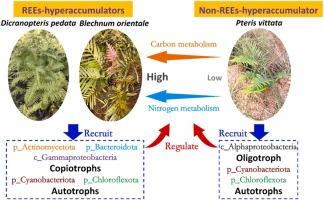Recruitment of copiotrophic and autotrophic bacteria by hyperaccumulators enhances nutrient cycling to reclaim degraded soils at abandoned rare earth elements mining sites
IF 12.2
1区 环境科学与生态学
Q1 ENGINEERING, ENVIRONMENTAL
引用次数: 0
Abstract
Hyperaccumulators harbor potentials for remediating rare earth elements (REEs)-contaminated soils. However, how they thrive in low-nutrient abandoned REEs mining sites is poorly understood. Three ferns (REEs-hyperaccumulators Dicranopteris pedata and Blechnum orientale, and non-hyperaccumulator Pteris vittata) along with their rhizosphere soils were collected to answer this question by comparing differences in soil nutrient levels, soil and plant REEs concentrations, and bacterial diversity, composition, and functions. Results observed lower soil pH (4.67–4.95 vs. 7.96), total carbon (TC) (0.35–0.62 vs. 2.84 g kg–1), total nitrogen (TN) (20–23 vs. 133 mg kg–1), and total phosphorus (TP) (81–91 vs. 133 mg kg–1) at sites Dp and Bo than site Pv. Hyperaccumulators efficiently extracted soil REEs and translocated them to fronds (up to 6897–7759 mg kg–1). Bacterial α diversity in three soils did not significantly vary. In contrast, bacterial composition at sites Dp and Bo was dominant by higher abundances of copiotrophic bacteria (18 % vs. 12 %, p_Actinomycetota; 3.3–8.3 % vs. 1.9 %, p_Bacteroidota; 8.3–14 % vs. 6.9 %, c_Gammaproteobacteria) and autotrophic bacteria (18 % vs. 13 %, p_Chloroflexota; 13 % vs. 8.6 %, p_Cyanobacteriota) when compared to site Pv. These bacteria likely acted as nutrient cyclers that promoted the growth of hyperaccumulators, based on functional predictions from DiTing analyses. This study provides new insights into nutrient recovery in abandoned REEs mining sites, offering strategies to reclaim degraded soils using phyto-microbial technology.

超蓄积体吸收共生和自养细菌,促进养分循环,对废弃稀土矿区退化土壤进行复垦
超蓄能器具有修复稀土污染土壤的潜力。然而,它们是如何在低营养的废弃稀土矿区茁壮成长的,人们知之甚少。为了回答这个问题,我们收集了三种蕨类植物(稀土-高富集植物Dicranopteris pedata和Blechnum orientale,以及非高富集植物Pteris vittata)以及根际土壤,通过比较营养水平、稀土浓度和细菌组成的差异。结果发现,Dp和Bo站点的土壤pH值(4.67 ~ 4.95比7.96)、总碳(TC)(0.35 ~ 0.62比2.84 g kg-1)、总氮(TN)(20 ~ 23比133 mg kg-1)和总磷(TP)(81 ~ 91比133 mg kg-1)低于Pv站点。超积累体有效地提取土壤稀土元素并将其转运到叶片中(6897 ~ 7759 mg kg-1)。3种土壤细菌α多样性差异不显著。相比之下,Dp和Bo位点的细菌组成以高丰度的共生菌(18% vs. 12%;3.3-8.3% vs. 1.9%, p_Bacteroidota;8.3-14% vs. 6.9% (c_Gammaproteobacteria)和自养细菌(18% vs. 13%, p_Chloroflexota;与Pv位点相比,13% vs. 8.6% (p_Cyanobacteriota)。根据DiTing分析的功能预测,这些细菌可能起到了营养循环器的作用,促进了超积累体的生长。该研究为废弃稀土矿区的养分恢复提供了新的见解,并提供了利用植物微生物技术回收退化土壤的策略。
本文章由计算机程序翻译,如有差异,请以英文原文为准。
求助全文
约1分钟内获得全文
求助全文
来源期刊

Journal of Hazardous Materials
工程技术-工程:环境
CiteScore
25.40
自引率
5.90%
发文量
3059
审稿时长
58 days
期刊介绍:
The Journal of Hazardous Materials serves as a global platform for promoting cutting-edge research in the field of Environmental Science and Engineering. Our publication features a wide range of articles, including full-length research papers, review articles, and perspectives, with the aim of enhancing our understanding of the dangers and risks associated with various materials concerning public health and the environment. It is important to note that the term "environmental contaminants" refers specifically to substances that pose hazardous effects through contamination, while excluding those that do not have such impacts on the environment or human health. Moreover, we emphasize the distinction between wastes and hazardous materials in order to provide further clarity on the scope of the journal. We have a keen interest in exploring specific compounds and microbial agents that have adverse effects on the environment.
 求助内容:
求助内容: 应助结果提醒方式:
应助结果提醒方式:


